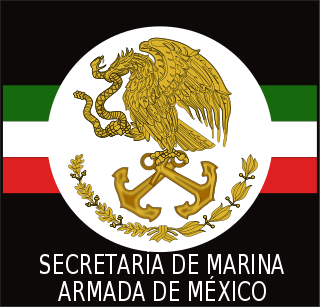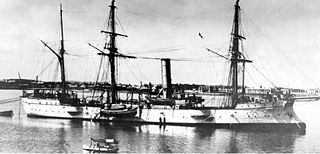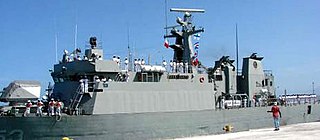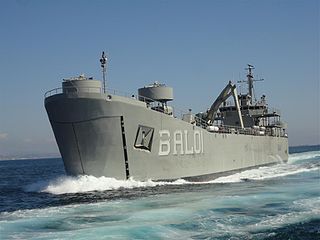
The Mexican Navy is one of the two independent armed forces of Mexico. The actual naval forces are called the Armada de México. The Secretaría de Marina (SEMAR) includes both the Armada itself and the attached ministerial and civil service. The commander of the Navy is the Secretary of the Navy, who is both a cabinet minister and a career naval officer.

The Sigma class is a Dutch-built family of modular naval vessels, of either corvette or frigate size, designed by Damen Group.

USS Newport (LST-1179) was the third ship of the United States Navy (USN) to bear the name of the Rhode Island city. The first of her class of landing ship tanks (LST), she was capable of a sustained speed of 20 knots. Her ability to adjust her draft, accompanied by her unique bow-ramp design, helped bring a new degree of responsiveness to the amphibious fleet. The ship was launched in 1968 and entered service with the USN in 1969. Assigned to the United States Atlantic Fleet for the entirety of her career, Newport made deployments to the Mediterranean and Caribbean Seas. The vessel was taken out of service in 1992 and laid up until 2001.

ARM Sonora (PO-152) is a Durango-class patrol vessel in service with the Mexican Navy with a 57 mm (2.2 in) main gun turret and a helicopter landing pad, primarily used for illicit drug interdiction. Like other ships of this class, it was designed and built in Mexican dockyards. The vessel was launched and commissioned on 4 September 2000 and is in active service.

The Durango class is an offshore patrol vessel class in service with the Mexican Navy. The Durango class, comprising four ships, was designed and constructed in Mexico in 1999–2000. The class entered service in 2000 and is used primarily for drug interdiction and patrol.

The Oaxaca class are offshore patrol vessels, constructed and designed by and for the Mexican Navy. The class is named after the Mexican state of Oaxaca. The Mexican Navy has requested seven of these ships with four already in service, three in construction, which were disclosed on June 1 on the Navy anniversary, with the name PO-163 Independencia, which is to celebrate the 200th anniversary of the Independence of Mexico. Also, another ship PO-164, named Revolucion, is in the process of raising the Mexican flag in a couple of months. Two more to be constructed in Navy's Naval Shipyards.

ARM Baja California (PO-162) is a Oaxaca-class patrol vessel, constructed by and for the Mexican Navy.

ARM Durango (PO-151) is the first of four Durango-class patrol vessels in the Mexican Navy. Like other ships of this class, it was designed and built in Mexican dockyards. The ship is armed with a main 57 mm (2.2 in) gun turret and a helicopter landing pad. The vessel is primarily used for interdiction of drug smuggling. Launched and commissioned on 11 September 2000, Durango is currently in service.
The Astilleros de la Secretaría de Marina, are also known as ASTIMAR. The yards are dependent on the Mexican General Directorate of Naval Construction of the Mexican Navy, which carries out various types of naval construction and repairs in the Mexican territory.

The Naval Infantry Corps are the naval infantry and amphibious infantry force of the Mexican Navy. The main task of the Infantería de Marina is to guarantee the maritime security of the country's ports and external and internal defense of the country. To accomplish these responsibilities, the corps is trained and equipped to take on any type of operations from Sea, Air and Land.

The Dutch shipbuilding firm The Damen Group, designs and manufactures a wide variety of vessels, including a range of related patrol vessels known generally as the Damen Stan Patrol vessels.

Zaragoza was a corvette of the Mexican Navy in commission from 1892 until 1926. Although designed as a ship of war, she spent most of her active career serving as a training ship.

The ARM Guanajuato (PO-153) is a Durango-class oceanic patrol vessel in the Mexican Navy with a 57mm main gun turret and a helicopter landing pad, currently primarily used for drug interception and maritime security in Mexican territorial waters. It is also armed with SA-18 Grouse missiles. Like other ships of this class, it was designed and built in Mexican dockyards, and is sometimes referred to as a compact frigate. It was named after the Mexican state of Guanajuato.

Timeline of Mexican Naval anti-drug cartel operations during the Mexican drug war are listed below:

Tenochtitlan-class patrol vessels is a Mexican Navy class of patrol vessels in 2012, that is based on the Damen Stan 4207 patrol vessel design. Over a dozen navies, coast guards and other government agencies operate vessels based on this design. While some of those vessels are equipped for purely civilian patrols, the Mexican vessels are armed with a pair of Browning M2 machine guns, and a jet-boat pursuit craft that can be launched and retrieved via a stern launching ramp, while the vessel is underway.

The Dutch shipbuilding firm The Damen Group, designs and manufactures a range of patrol vessels, of various sizes, including the Damen Stan 4207 Patrol Vessels. The Damen Stan patrol vessel designs' names include a four digit code, where the first two digits are the vessel's length, in metres, and the second two digits are its width.

ARA La Argentina was a steam corvette that served as a training ship with the Argentine Navy between 1884 and 1895, and in other roles until decommissioned in 1899.

The Murature-class patrol ships are a class of World War II era Argentine Navy warships, originally classified as minelayers and later reclassified as patrol ships. The class is named after José Luis Murature, Foreign Minister of Argentina from 1916 to 1918.

The ARM Guanajuato (C-07), also known as Cañonero Guanajuato, was a gunboat that served for the Mexican Navy until 2001. It is currently located at the shore of the Jamapa River, in the municipality of Boca del Río, Veracruz.

The Montes Azules-class logistics ship is a class of logistics ships that are operated by the Mexican Navy. They are sometimes referred to as transport ships.

















